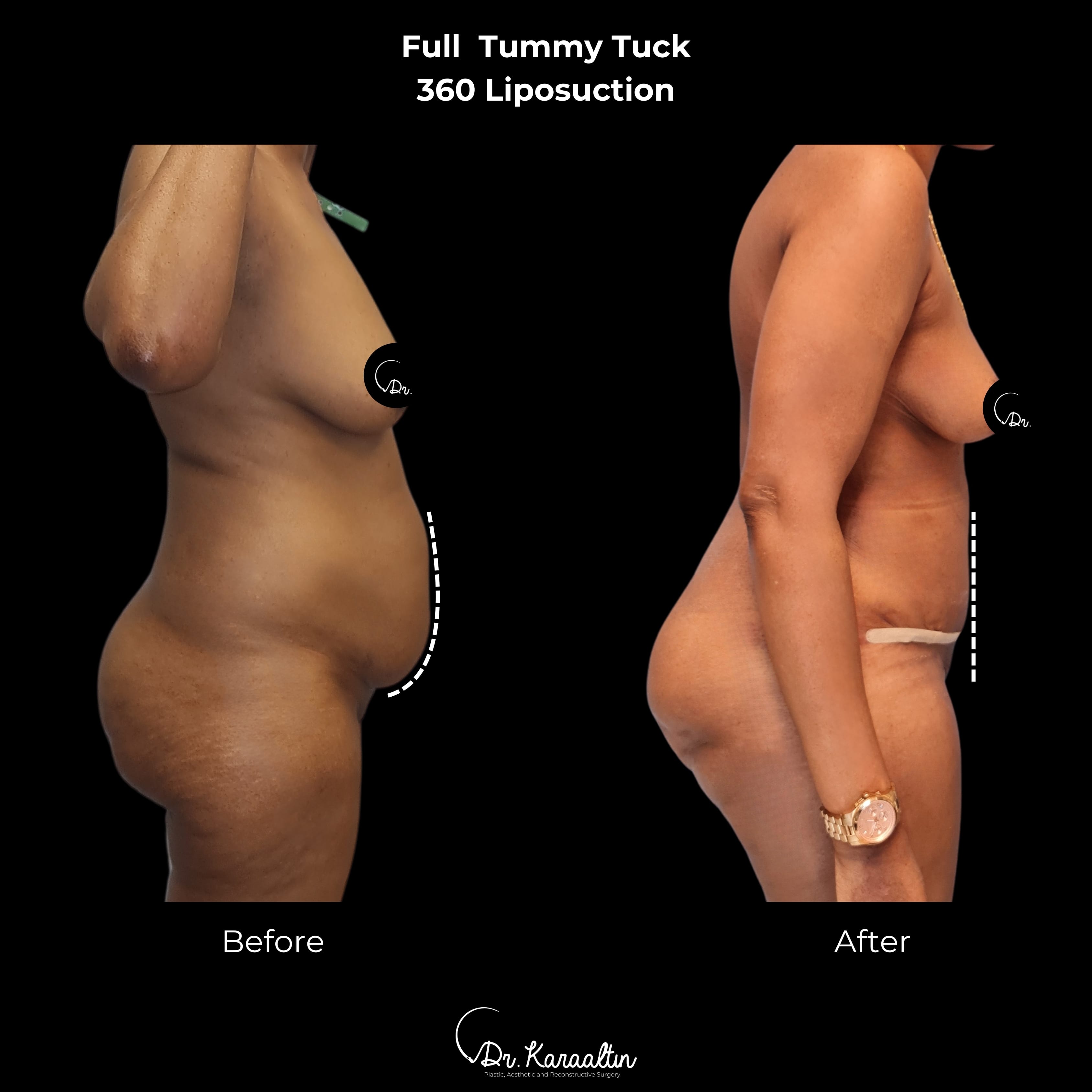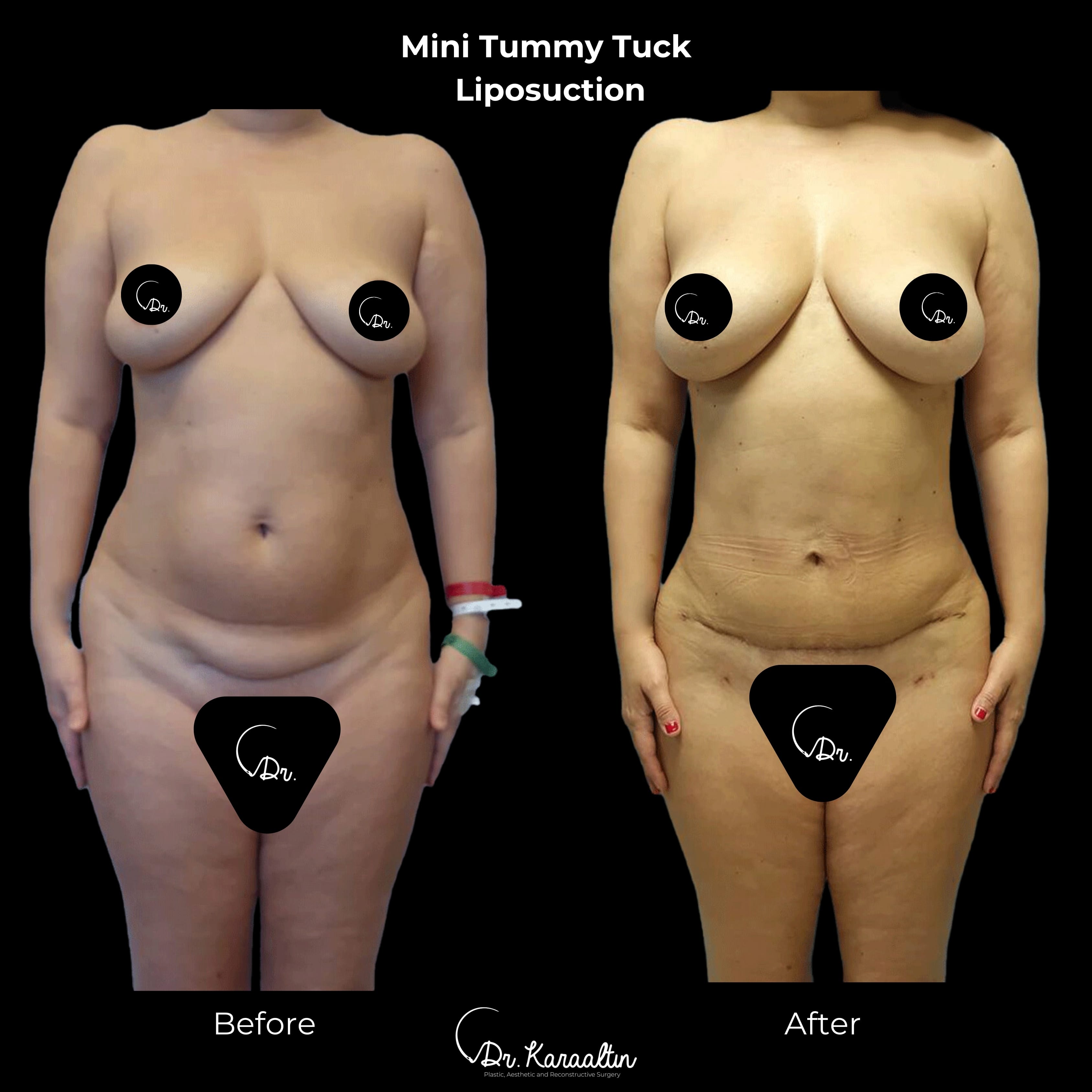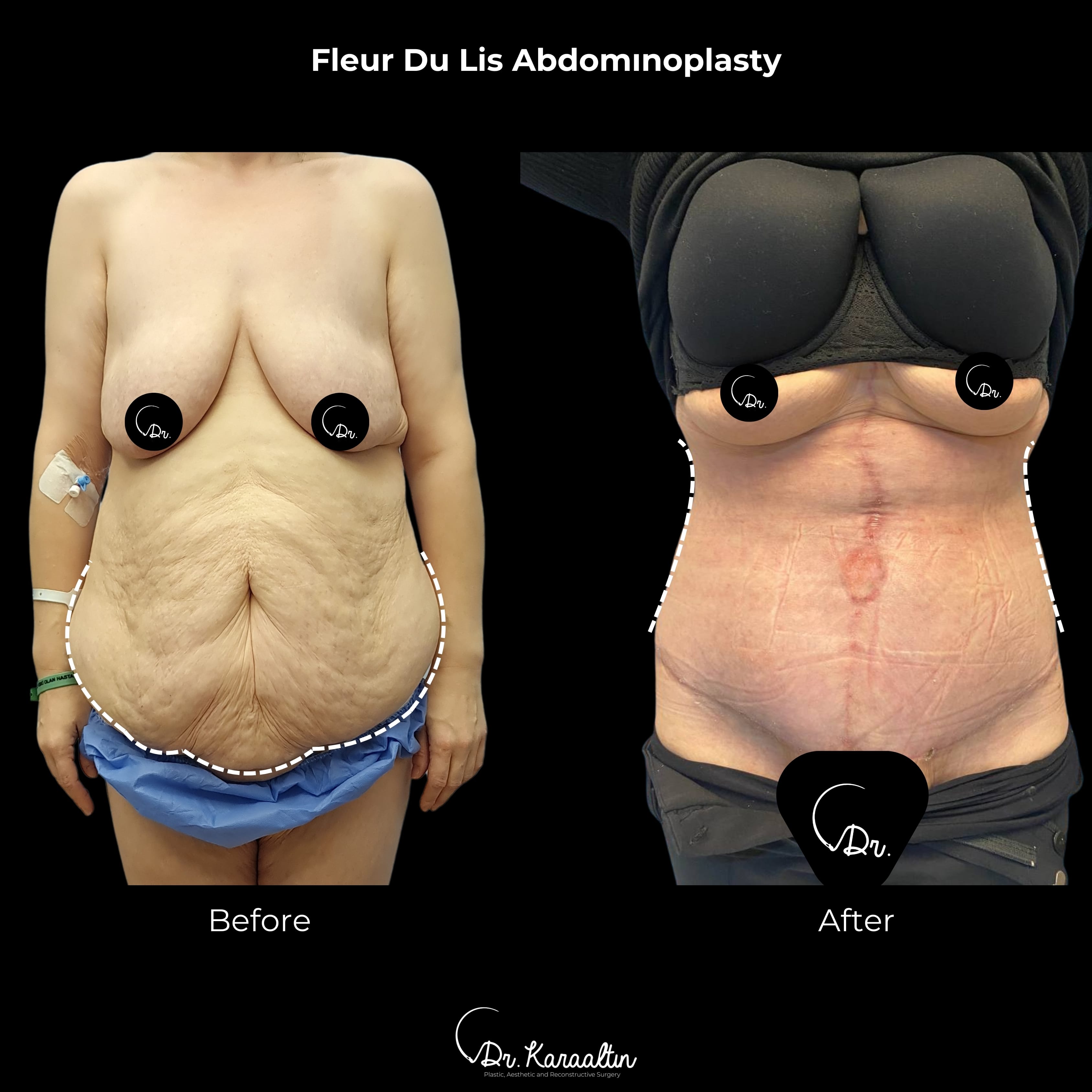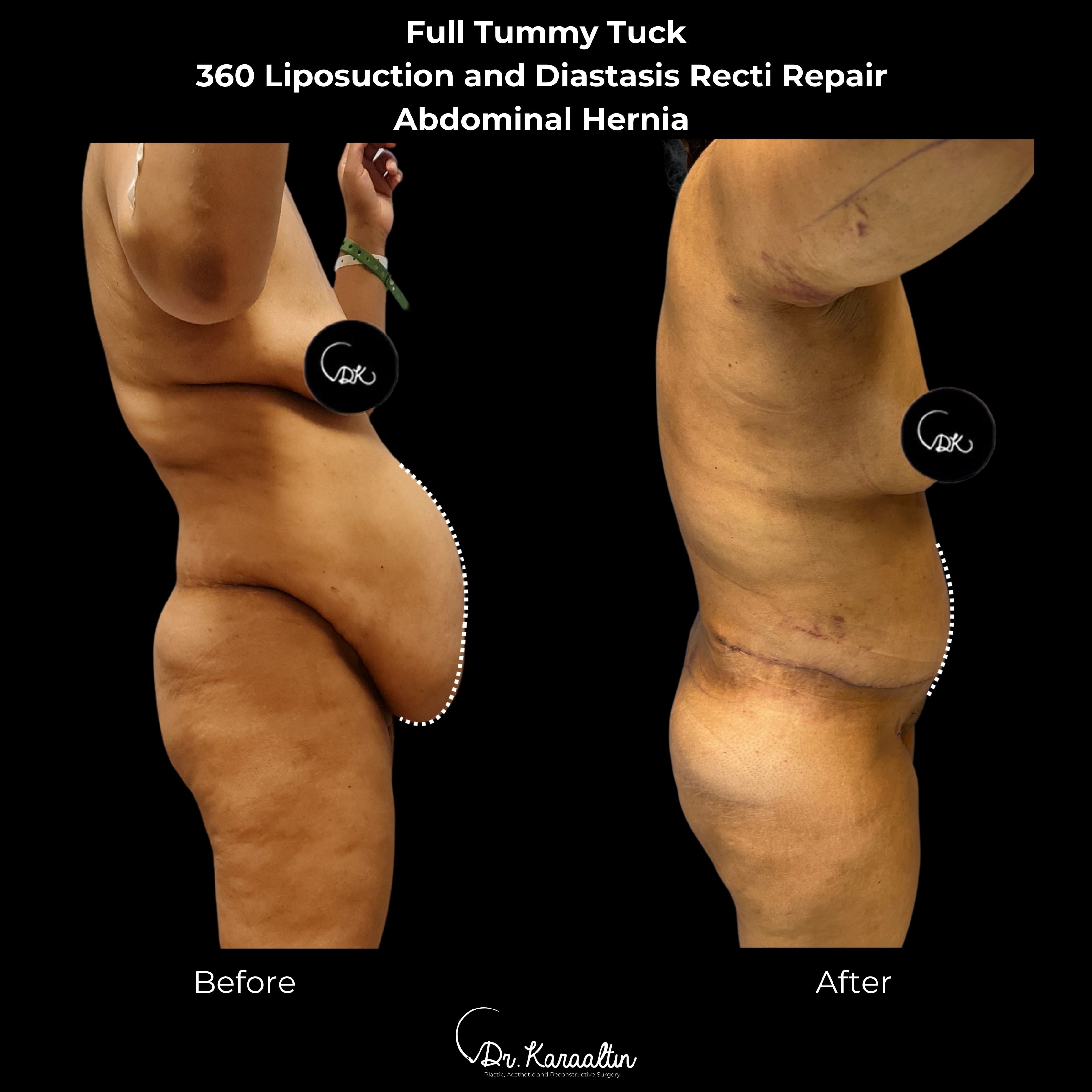
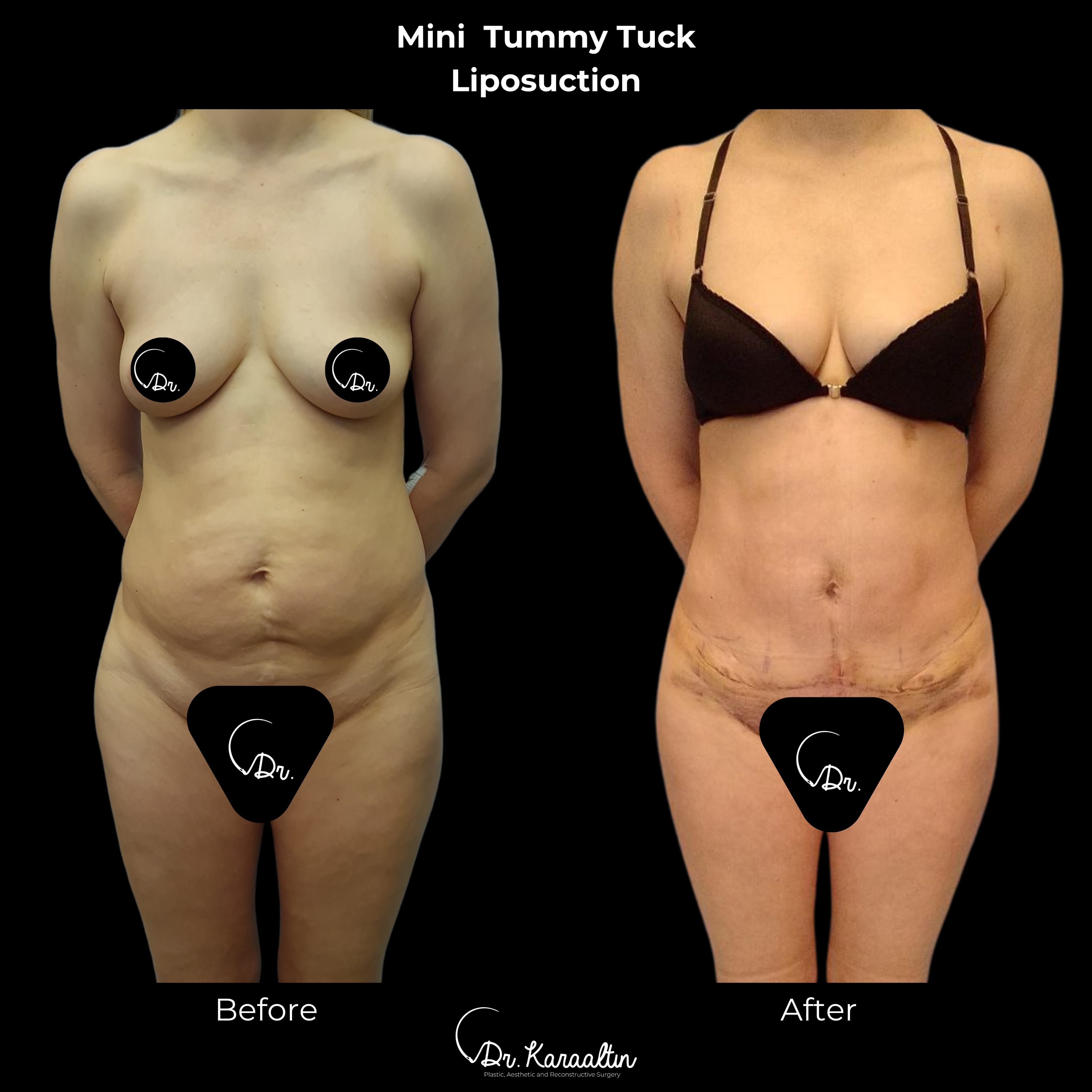
The tummy tuck surgery has consistently been one of the most popular cosmetic surgeries all around the world for men and women alike. The procedure has evolved in the last decade, making it even more safe and effective.
Also called abdominoplasty surgery, the tummy tuck is a surgical procedure used to thin and transform the waistline re-shape the torso and convert the abdominal muscle laxity to a nulligravida status. Unlike liposuction alone, it provides an overall transformation by reducing the size of the waist considerably. In addition to correcting loose skin and excess fat, the procedure also tightens the fascia muscles on the abdomen wall to reverse stretching caused by weight gain or pregnancy.
An abdominoplasty has two major components: One is the skin and fat that occurs beneath the skin and above the muscles of the abdominal wall. We refer to this fat as "pinchable fat," as opposed to the fat that occurs beneath the abdominal muscles inside the stomach. That fat, also referred to as visceral fat, lies within the abdomen and is therefore not “pinchable.” The other component of some tummy tucks is the muscle, whose front portion you can feel with your fingertips when you pinch the skin and fat of your abdomen.
As part of normal human anatomy, there is a thin fine line called “Linea alba” between the two vertically oriented rectus muscles in the front of the abdomen. As one of the natural changes that occur during pregnancy or major weight gain, the abdominal wall stretches. In some women, the “Linea alba” between the two muscles stretches and does not return to normal. This is called a diastasis recti (Rectus: abdominal muscle).
To repair diastasis recti during an abdominoplasty, the muscle fascial edges are sutured together, thereby tucking in the loose abdominal wall. Sutures can also be placed at other portions of the abdominal wall to create further tightening and shaping of the muscle.
While tightening the abdominal muscles during an abdominoplasty can provide substantial improvement for some of our patients, this can lead to some abdominal soreness during recovery. When a patient has abdominal muscle weakness, or abdominal wall laxity, they may be a candidate for abdominal muscle tightening during the abdominoplasty procedure.
When the patients abdominal skin laxity is borderline and the skin above the naval is not appropriate to be advanced to the horizontal skin excision line, a mini abdominoplasty procedure is indicated. The muscle wall repair can be performed with endo-vision assistance while the skin can be draped and tuckered to lingerie line leaving the naval (umbilicus) opening unchanged. Usually, this surgery is combined with liposuction to refine the side walls and create the hourglass figure in return.
In many patients, there is no real problem with the abdominal wall. For patients whose primary complaint is their loose skin and fat, there is no need to perform any suturing of the muscles. Typically, these patients will not complain of abdominal pain following their surgery; An abdominoplasty that removes loose skin but does not tighten the underlying abdominal muscles is called a skin-only abdominoplasty. This procedure can also be combined with a sculpting liposuction procedure to refine and define the abdominal side walls as well as the flank and love handle regions.
The umbilical float tummy tuck inscion is made at the base of the abdomen, just below the lingerie line. Through this inscion the abdominal skin is elevated till the chest margin. The belly button is dissected internally and alongside. The belly button is detached from the abdominal wall from its internal attachment. The belly button is re-attached to a lower point defined by the extent the tummy skin is stretched down. Then the floating belly is once more attached to the new position with proper alignment and evenness of the abdominal skin. Incisions are closed with proper dissolvable sutures.
Abdominoplasties can either tighten skin alone, or both skin and underlying abdominal muscles. The distinction between a mini and total tummy tuck is relevant to the amount of loose skin that needs to be removed.
The skin of the abdominal wall can be divided into that which is above the umbilicus (belly button) and that which is below. At the of consultation the surgeon will determine to what extent the looseness of the skin above the belly button is a problem. Often, it is, especially in older patients. If it is indeed a problem, then the only way to tighten that skin is to place a circumumblical inscion so that the upper abdominal skin can be pulled down without lowering the umbilicus at the same time.
In cases when only skin below the belly button is loose, then only that skin needs to be removed. Therefore, there would be no need for an inscion around the umbilicus, and the lower abdominal scar may be shorter in length, depending on the amount of skin that needs to be removed.
A typical case for a mini abdominoplasty may be a woman in her 30s or 40s who has had a c-section, with loose skin of the lower abdomen, bulging out over the scar. In such a case, the lower abdominal muscles may or may not be repaired, depending on the conditions in each individual case.
In cases where is loose skin above the belly button, a full abdominoplasty (with an inscion around the belly button) will most likely be required to tighten the upper and lower abdominal skin. During the consultation, the surgeon will discuss whether to tighten the muscle in addition to the skin.
A difficult aspect of abdominal contouring is the management of patients with excessive epigastric laxity. As more as individuals undergo bariatric-assisted weight loss, the acuity and severity of the associated weight reduction results in patients who are burdened by a huge pendulous skin flaps over laying one each other, rashes in skin folds, chronic skin irritation or breakdown. Unlike the typical abdominoplasty patient who has excessive skin and fat in the vertical orientation with minimal redundancy in the transverse direction, individuals with massive weight loss have excessive laxity in both vertical and horizontal axes. Therefore, the fleur-du-Lis technique enables a skin excision on both axes leaving an inverted T-scar.
The initial approach to the vertical abdominoplasty is like that of the traditional procedure. The lower horizontal belly inscion is marked whereas the vertical extends from the chest bone to the mid-line of the lower inscion. The skin is removed in a lily flower fashion, and therefore it is called the Fleur-du-Lis abdominoplasty.
This is a modification of the mini- abdominoplasty for patients who have a large excess of skin and fat hanging down over the pubic area. In this procedure only the surplus skin and fat is removed. The scar is long, extending from one side of the tummy to the other.
Lipo-abdominoplasty is a new, more physiological, and versatile operation that drastically reduces complications, extends the indications for patient recruitment to the obese and super obese populations and simplifies the surgery while also giving a better aesthetic result with quicker recovery. Is a technique where the tummy tuck procedure is combined with abdominal liposuction.
LABP starts with extensive liposuction first to reduce the fat in the abdominal panniculus and to achieve lipo-mobilization of the flap. Only 3- and 4-mm cannula are used. Liposuction first has several advantages in all patients and especially in the obese. In obese patients, the flap in traditional abdominoplasty remains fatty and thick. This fat is a parasite on the blood supply of the flap and is susceptible to fat necrosis, with all the resultant sequalae of infection and contour irregularities. In LABP, liposuction eliminates most of the parasitic fat but retains many neurovascular connections intact. In fact, thicker the abdominal wall fat, better is the mobilization achieved. The thinned abdominal flap also can reveal anatomical contours and musculature better avoiding the featureless flat abdomen look.
The key technical elements of this procedure include direct undermining limited to the paramedian area of the abdomen, discontinuous undermining to rib margins and flanks as needed, skin resection pattern with significant lateral resection and highest tension wound closure placed laterally, superficial fascial system repair with permanent sutures along the entire incision, and liberal use of adjunctive liposuction in the upper abdomen and the lateral and posterior trunk.
The scar from an abdominoplasty must, by necessity, be a long scar to remove the large area of skin. The surgeon frequently likens this scar to a brim on fabric; the edge must cover the length of the area to be reduced. In fact, it has seen some extremely unfavorable results when efforts have tried to achieve the results of a full tummy tuck with a short scar.
Incisions for a tummy tuck most commonly extend from hip bone to hip bone as well as a small incision around the belly button confined in the lingerie line. Any stretch marks in that area will be removed as well. The belly button is brought out through a new opening but stays in its original place on the abdominal wall. If liposuction is a part of your procedure, these additional incisions are very small and generally made in an area of tissue to be removed.
The mini tummy tuck is best for those who have minimal excess skin or roundness that is limited to the area just below the belly button. This can be done with a shorter incision - often the same length or a bit longer than a typical C-section scar. The incision and recovery for a mini tummy tuck are often less than that of a more traditional abdominoplasty.
For patients with a lot of excess skin due to multiple pregnancies or a large amount of weight loss, an extended incision may be recommended. Patients who have successfully lost weight with gastric bypass or diet and exercise more than 100 lbs. (45 Kgs) can have laxity and excess tissue that extends both horizontally and vertically. The procedure is sometimes referred to as a fleur-de-lis tummy tuck. In addition to the standard tummy tuck incision, it includes a vertical incision from the lower breastbone to the pubic bone. The final scar will resemble a large upside-down T.
A tummy tuck surgery is a significant surgery. Because of the skin removal, it is crucial that the area of closure be kept under minimal tension for the first several days after the operation. Therefore, all abdominoplasty patients are instructed to walk bent over whenever they are upright for the first 5-7 days depending on the type and internal repair.
full abdominoplasty patients are required to stay for two days in the hospital under the supervision of a nurse and doctors, both for patient safety as well as comfort. The nurse ensures that the patient is resting in the proper semi-fowler position (back elevated 30-40 degrees, legs bent with pillows under the knees). The nurse monitors blood pressure, as well as discomfort and can medicate accordingly, as needed. The nurse also monitors drainage (drains are almost always used) and instructs the patient on drain care for the days following their abdominoplasty. Typically, between days 5 and 7 following surgery, drainage is low enough that the patient can come into the office and have her or his drains removed. At this point, the patient can stand upright again.
The minimum downtime after abdominoplasty surgery is about 10 days. If surgery is performed on a Friday, one can generally expect drains to be removed the following Tuesday or so, and one may return to very non-active work 10 days after surgery. However, it must be emphasized that even at 10 days after an abdominoplasty, activity must be kept at a minimum to ensure proper healing and to avoid complications.
A full tummy tuck procedure would last about 2.5-3 hours to perform. Adding liposuction into the procedure would add an extra 1-2 hours. A mini tummy tuck, on average, takes between 1 and 2 hours to perform.
General anesthesia is typically utilized for abdominoplasty surgery. Epidural anesthesia may be indicated in selected cases.
Smoking cigarettes, creates a significant disturbance of blood circulation within the skin. This can lead to a major complication in surgeries where the skin is manipulated, such as face lift or abdominoplasty. These complications can include skin loss, which eventually ends up with an open wound and poor scarring.
Like all surgical procedures, there is always a possibility of complications or side effects and, although rare, these can include infection, nerve damage, blood clots, hematoma, seroma, swelling and an irregular or a “lop-sided” appearance after the operation. Lung and fat embolism are also rare seen complications.
Abdominoplasty is commonly performed as part of a Mommy Makeover along with breast lift with or without augmentation, breast augmentation, breast reduction, liposuction, and vaginal rejuvenation or in certain conditions as a part of a Brazilian Butt Lift procedure (BBL).
Patients who have undergone massive weight loss (post-bariatric surgery) commonly face issues with excess skin, including excess skin in the back and buttock area, thighs, arms, breasts, and face. Our plastic surgeons can combine some of these procedures in a single surgery using Dr. Karaaltın’s mix-max algorithm, prioritizing safety and optimizing your recovery process by staging the procedures when necessary.
After your Tummy Tuck, you will be placed in an abdominal binder or garment. You will have a light dressing covering the incisions. Swelling is typical after Tummy Tuck. You may shower 24 hrs. after the procedure. Our medical staff and surgeons employ a multimodal pain regimen to decrease your need for narcotic pain medication, which allows our patients to recover quickly and feel more like themselves soon after surgery. Our Tummy Tuck patients can expect to return to work on average of 2-3 weeks.
Initially, Dr. Karaaltın and his team will either examine you daily or stay in contact to ensure that your healing is progressing properly. Most of the swelling will subside within the first few weeks, but it may persist for a few months after the procedure. During the recovery process, we advise avoiding heavy lifting and strenuous activities for 6 weeks.
Dr. Karaaltın Clinic's team offers two unique modalities to provide our abdominoplasty patients with a more comfortable, precise, and aesthetically superior experience.
Postoperative pain management is crucial from a patient perspective, and early mobilization and discharge are goals after the abdominoplasty procedure. Dr. Karaaltın Clinic’s medical team has developed a special technique for introducing an epidural catheter under the rectal sheath, connected to a patient-controlled anesthetic pump. This modality provides smoother recovery by reducing opioid use, promotes early ambulation, and may result in a shorter hospital stay.
Dr. Karaaltın Clinic’s surgical team has extensive experience with over 1000 liposuction cases using Vibrosat-pro technology (Möller, Germany). This technology uses a vibration expansion concept to selectively emulsify fat tissue while providing profound skin contraction. With this modality, it is possible to achieve concave contours on the abdomen, significant definition in the flanks and love handles, and an overall improved outcome.
A lot of patients have this question when they come in for a Tummy Tuck.
BMI (body mass index) is a great tool doctors use to help determine the patient’s general type as well as the surgical strategy. However, BMI does not completely determine if a patient is healthy enough to undergo surgery and anesthesia.
There is no strict BMI cutoff for a surgical indication, but as a patients BMI goes above 30 extra precautions, more pre-operative testing and perhaps splitting the procedure into multiple sessions.
Body type is a combination of frame size, and the ratio of body fat muscle mass relative to height. The skeletal frame is also a crucial component that defines it. There are three main body types:
Research shows that genetics has a substantial influence on body type, particularly on ectomorphy and mesomorphy. This is important because it helps explain individual differences in both physique and athletic performance, that can’ be explained by lifestyle factors such as nutrition and exercise alone.
Endomorphs and to a lesser extent ectomorphs have a high tendency to have a high volume of visceral fat deposit. This would interfere with the timing and indication of the Tummy Tuck procedure. In this condition, patients should lower there BMI to the level where the visceral fat deposit will allow the surgeon to perform the optimal inner plication repair during their Tummy Tuck procedure.
Body mass index (BMI) is a value derived from the mass (weight) and height of a person. The BMI is defined as the body mass divided by the square of the body height, and is expressed in units of kg/m2, resulting from mass in kilograms and height in meters.
The BMI is expressed in kg/m2, resulting from mass in kilograms and height in meters. If pounds and inches are used, a conversion factor of 703 (kg/m2)/(lb./in2) is applied. When the term BMI is used informally, the units are usually omitted.
There are thousands of things you should know about Tummy Tucks but here are four highlighted aspects that a patient should know to proceed!
So, the first thing that you we need to know is that whenever you’re getting a Tummy Tuck combined with a liposuction there are safe areas of liposuction and unsafe areas of liposuction that should be taken meticulously. This is something that is debatable, and we run into problems with a lot whenever we’re having patients that are going to providers that are not necessarily trained to do these procedures and promise bold options. So let us explain you why we should be careful in our selection of the liposuction when performing a Tummy Tuck procedure. So, there’s certain areas like the sides or back that have been found safe for liposuction. those are called the flanks; love handles and upper back. Current trends and the progress in the liposuction procedures in modern plastic surgery drive the indication to combine liposuction with almost all the Tummy Tucks. The areas we cannot really liposuction or should be very careful are between the oblique abdominal muscles and the middle part of the abdomen. So, whenever you have a Tummy Tuck procedure, your blood supply to your tummy skin is cut off completely from the bottom part and so that blood supply to the skin then must come from another area. If you’re liposuctioning the danger zones (above mentioned), that can block the blood supply from the side area. you have a potential of damaging all the blood supply that’s now coming to the skin and that can cause wounds down at the bottom part.
Two, is what we call the internal corset or muscle plication. In an abdominoplasty procedure 2 groups of muscles are involved in the corrective Procedure called ab or rectus abdominal muscles. So, with pregnancy or with weight gain, separating of those rectus abdominis muscles happens, and that creates something called diastasis recti which is the separation of those muscles. The internal corset repair will bring those rectus abdominis muscles back together to its original setup. In this repair either permanent or late dissolvable sutures are used starting from top to bottom, bringing all of that together.
The third thing is progressive tension sutures. Progressive tension is a way that we can distribute tension along the areas of the skin flap (i.e.: your abdominal skin that’s lifted) and sutures are stitched. During lifting the abdominal skin, a large area is prone to accumulate tissue fluid collections (seroma). To minimize this problem, internal kilting stiches are placed to minimize the dead space and relieve the tension on the edge of the inscion site. This will minimize the seroma rate as well as the vertical kilting sutures will improve the abs appearance.
The fourth thing is the type of scar. Every patient wants to know what scar they’re going to have from a Tummy Tuck. The first thing you should know is that scars should be kept in the lingerie line “low”. The surgeon will mark almost as low as possible, yet in certain circumstances we cannot go down with getting as much skin from the top so that we might get a “T” incision in return.
You may benefit from this procedure if you have the following characteristics:
This technique complies not applying suctions drains, using bidirectional barbed absorbable sutures for the muscle plication repair and deploying kilting stiches on the elevated abdominal skin flap to minimize the dead space and tension of the closure line.
Yes. Medical studies have shown that abdominoplasty alone or in combination with liposuction and aesthetic breast surgery can be performed safely, with an acceptable complication profile.
The dog ear is a common skin deformity resulting from attempted closure of unfavorably shaped defects or from transfer of many local flaps. Prevention is possible in many instances and surgical correction is usually feasible when the deformity appears.
Simultaneous liposuction during a Tummy tuck procedure can minimize the occurrence of dog ear deformities postoperatively.
The BODY-Q is a condition-specific patient-reported outcome measure that enables a comprehensive assessment of outcomes that are specific to patients undergoing body contouring procedures such as abdominoplasty. The BODY-Q scales were designed to be responsive to the effects of abdominoplasty on health-related quality of life and appearance outcomes.


